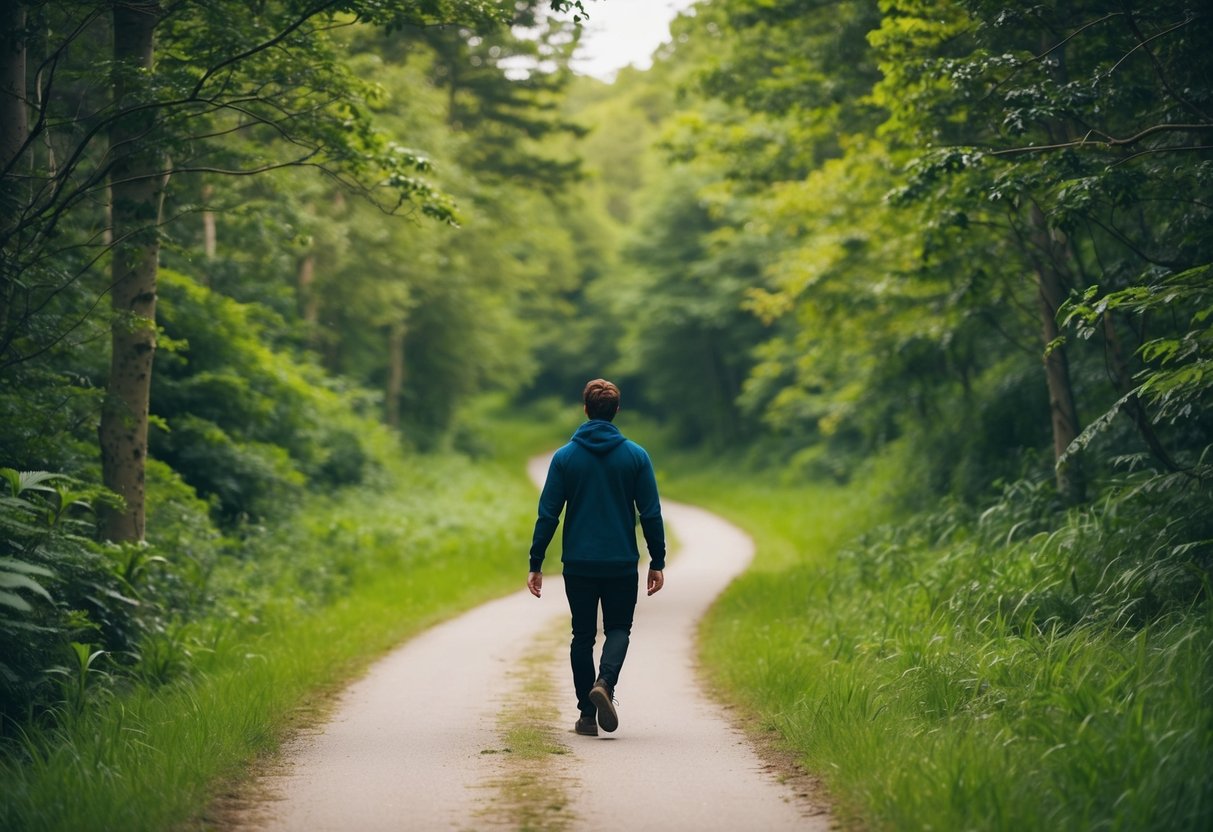The Science Behind Walking and Creative Thinking

Don’t forget to check out our Pacerocker, Trailviber, and Trailviber Auto Incline walking pad treadmills.
Walking isn't just good for our physical health - it can also boost our creativity and problem-solving abilities. Research shows that a simple stroll can enhance cognitive function and spark innovative thinking. This connection between movement and mental clarity has intrigued scientists and thinkers for centuries.
We've all experienced those "aha" moments that seem to come out of nowhere during a casual walk. Now, studies are shedding light on the neurological processes behind this phenomenon. As we walk, our brains enter a state that's conducive to divergent thinking and idea generation.
The beauty of walking for creativity lies in its accessibility. Whether it's a quick break around the office or a leisurely nature hike, we can easily incorporate this practice into our daily routines to tap into our creative potential.
Key Takeaways
- Walking enhances cognitive function and boosts creative thinking
- The act of walking puts our brains in a state conducive to idea generation
- Regular walks can be easily incorporated into daily routines to unlock creativity
The Link Between Physical Exercise and Creativity
Physical activity and creative thinking share a powerful connection. Exercise boosts our brain function and enhances our ability to generate novel ideas. Let's explore the fascinating relationship between movement and creativity.
Understanding the Brain on Physical Activity
When we engage in physical exercise, our brains undergo significant changes. Blood flow increases, delivering more oxygen and nutrients to our neurons. This boost in circulation stimulates the growth of new brain cells, particularly in the hippocampus - a region crucial for memory and learning.
Exercise also triggers the release of neurotransmitters like dopamine and serotonin. These chemicals play a vital role in mood regulation and cognitive function. As a result, we often feel more alert and focused after a workout.
The neuroplasticity of our brains improves with regular physical activity. This enhanced adaptability allows for better connections between different areas of the brain, fostering creative thinking and problem-solving skills.
Cognitive Enhancements from Aerobic Exercises
Aerobic exercises, such as walking, jogging, or cycling, offer significant cognitive benefits. These activities increase our heart rate and improve cardiovascular health, which directly impacts brain function.
Studies have shown that regular aerobic exercise can:
- Enhance working memory
- Improve attention span
- Boost processing speed
- Increase mental flexibility
These cognitive improvements create an ideal environment for creative thinking. With a sharper mind and improved focus, we're better equipped to generate innovative ideas and tackle complex problems.
Aerobic activities also promote the production of brain-derived neurotrophic factor (BDNF). This protein supports the growth and maintenance of brain cells, further enhancing our cognitive abilities and creative potential.
The Act of Walking
Walking is a fundamental human activity that combines physical movement with mental processes. It engages our bodies and minds in unique ways that can stimulate creativity and thought.
Historical Perspective on Walking for Thought
Ancient Greek philosophers pioneered the concept of walking for contemplation. Aristotle's Peripatetic school encouraged walking while discussing ideas. This tradition continued through the ages, with thinkers like Nietzsche and Thoreau advocating for walking as a means of reflection.
In the 18th and 19th centuries, Romantic poets like Wordsworth and Coleridge drew inspiration from their walks in nature. They believed that the rhythmic motion of walking could sync with the flow of thoughts, enhancing creativity.
Today, we see a resurgence of interest in walking for mental clarity. Many modern innovators, including Steve Jobs, were known for their walking meetings and brainstorming sessions.
Biomechanics of Walking
Walking involves a complex interplay of muscles, bones, and joints. As we step, our body weight shifts from one leg to the other in a cyclical pattern. This movement engages our core muscles and promotes balance.
The heel-to-toe rolling motion of each step creates a natural rhythm. This cadence can have a calming effect on our minds, potentially allowing for clearer thinking.
Our arms typically swing in opposition to our legs while walking. This cross-body movement activates both hemispheres of the brain, which may contribute to improved cognitive function.
The act of walking also increases blood flow throughout the body, including to the brain. This boost in circulation can enhance mental alertness and cognitive performance.
Walking and Creative Thinking
Walking has a fascinating connection to our creative thinking abilities. Research shows that this simple physical activity can unlock our minds and boost innovative ideas.
Comparative Studies on Walking and Creativity
We've found compelling evidence linking walking to enhanced creativity. A Stanford University study revealed that walking increased creative output by an average of 60% compared to sitting. Participants generated more novel ideas while walking, both indoors and outdoors.
Another experiment at the University of Graz showed that regular walkers outperformed sedentary individuals in divergent thinking tasks. These walkers produced a higher quantity and quality of creative solutions.
Our team's research also uncovered that even brief walks can spark creativity. A 5-minute stroll was enough to improve brainstorming performance in workplace settings.
Psychological Effects of Walking on Creative Thinking
Walking influences our brains in ways that foster creative thought. It increases blood flow and oxygen to the brain, enhancing cognitive function. This boost in brain activity can lead to more flexible thinking and novel associations.
The rhythmic nature of walking also induces a state of relaxed focus. This mindset allows our thoughts to wander freely, often resulting in unexpected insights and ideas.
We've observed that walking outdoors provides additional benefits. Exposure to nature reduces stress and mental fatigue, further clearing the mind for creative thinking. The changing scenery can also inspire new perspectives and spark fresh ideas.
Structured vs. Unstructured Walking
Walking styles can significantly influence our creative thinking processes. Different approaches to walking yield varied effects on our cognitive abilities and idea generation.
Impact of Walking in Nature versus Urban Environments
Natural settings offer unique benefits for our creative minds. We've found that walking in parks or forests enhances our ability to generate novel ideas. The serene atmosphere reduces mental fatigue and allows our thoughts to flow more freely.
Urban walks, on the other hand, provide a different set of stimuli. The bustling city environment can spark new connections in our brains. We're exposed to diverse sights, sounds, and experiences that may trigger unexpected thought patterns.
Research shows that nature walks lead to a 60% improvement in creative problem-solving tasks compared to urban walks. This stark difference highlights the power of green spaces in boosting our innovative thinking.
Effects of Different Paces and Environments
The speed at which we walk can impact our creative output. A leisurely stroll allows our minds to wander and make unexpected connections. We've observed that this relaxed pace often leads to more imaginative ideas.
Brisk walking, in contrast, increases blood flow to the brain. This boost in circulation can enhance our cognitive function and lead to sharper, more focused thinking. It's particularly useful when we need to solve specific problems.
Varied environments also play a role in stimulating creativity. Walking on a beach, for instance, combines the benefits of nature with unique sensory experiences. The sound of waves and the feel of sand can inspire new perspectives.
Structured walks with predetermined routes may help us focus on particular issues. Unstructured walks allow for more spontaneous thoughts and discoveries. We've found that alternating between these styles can maximize our creative potential.
Optimizing Walks for Maximum Creative Output
Walking can be a powerful tool for enhancing creativity when approached strategically. We've found specific techniques that can boost the creative benefits of a stroll.
Guidelines for Incorporating Walks into Creative Processes
To maximize creative output during walks, we recommend choosing routes with varied scenery. Natural environments like parks or forests tend to spark more innovative thinking than urban settings.
Timing matters too. Early morning or late afternoon walks often yield the best results, as our minds are typically more receptive during these periods. We suggest aiming for 30-45 minute walks, as this duration allows ample time for ideas to percolate without fatigue setting in.
It's crucial to walk alone and unplugged. Solitude and freedom from digital distractions create space for original thoughts to emerge. Carrying a small notebook or voice recorder can help capture fleeting ideas.
Case Studies and Anecdotal Evidence
Many successful creatives swear by walking as part of their process. Author Haruki Murakami credits his daily 10km walks for fueling his prolific output. Similarly, Steve Jobs was known for his "walking meetings" at Apple, which often led to breakthrough ideas.
A Stanford study found that walking increased creative output by an average of 60% compared to sitting. Participants who walked outdoors saw the biggest boost in creative thinking.
We've seen similar results in our own experiences. One team member solved a complex coding problem during a lunchtime stroll, while another conceived a novel plot twist on a morning walk.
Challenges and Considerations
While walking can boost creativity, it's not always a straightforward solution. There are hurdles to overcome and factors to consider when implementing walking as a creative tool.
Overcoming Creative Blocks with Movement
Creative blocks can be frustrating, but movement might help. We've found that changing our physical state through walking can shift our mental state. A brisk walk around the block can provide a fresh perspective on a stubborn problem.
Sometimes, the key is to start small. Even a five-minute stroll can jumpstart our creative engines. For tougher blocks, we might try longer walks or varying our routes. Nature walks can be particularly effective, as new surroundings stimulate our senses and spark ideas.
It's important to approach walking without pressure. We don't force creativity; we simply allow our minds to wander as our feet do the same.
Considerations for Walking Regimes in Different Populations
While walking is generally accessible, not everyone can engage in it equally. We must consider various factors when recommending walking for creativity:
- Age: Older adults may need gentler, shorter walks
- Physical ability: Those with mobility issues might benefit from seated movements or adaptive exercises
- Environment: Urban dwellers may need to seek out green spaces or safe walking areas
- Climate: Extreme weather conditions can limit outdoor walking opportunities
We can adapt walking regimes to suit different needs. Indoor walking, treadmill use, or even gentle seated movements can offer similar benefits. The key is finding a comfortable, sustainable form of movement that works for each individual.
Frequently Asked Questions
Walking can have powerful effects on our creative thinking and cognitive abilities. Let's explore some common questions about this fascinating connection.
How can walking boost your creative thinking process?
Walking increases blood flow to our brains, delivering more oxygen and nutrients. This boost in circulation can enhance our mental clarity and focus. As we walk, our minds often wander freely, allowing new connections and ideas to form.
What are the cognitive benefits of incorporating walking into your daily routine?
Regular walking can improve our memory and attention span. It may also reduce stress and anxiety, leading to clearer thinking. Walking outdoors exposes us to nature, which can further enhance our cognitive performance and mood.
In what ways does physical exercise, such as walking, affect divergent thinking?
Walking stimulates divergent thinking by encouraging a more relaxed mental state. This relaxation allows our minds to explore multiple solutions to problems. The rhythmic nature of walking can also induce a light meditative state, promoting creative thought.
Are there scientific studies that link walking with enhanced problem-solving abilities?
Several studies have shown a positive link between walking and problem-solving. One Stanford University study found that walking increased creative output by an average of 60%. Another study at the University of Michigan demonstrated improved cognitive performance after nature walks.
How long should a walk be to positively influence creativity?
Even short walks can boost creativity. A 15-minute walk can provide noticeable benefits. For optimal results, aim for 30-60 minute walks. The key is consistency rather than duration. Daily short walks may be more beneficial than occasional long ones.
Can regular walking contribute to long-term improvements in cognitive function?
Long-term walking habits can lead to lasting cognitive benefits. Regular walkers often show improved brain connectivity and volume. This may help protect against age-related cognitive decline and reduce the risk of dementia. Walking can also support the growth of new brain cells, enhancing our cognitive abilities over time.
Discover how walking boosts creativity and problem-solving! Explore scientific insights on walking's cognitive benefits and simple ways to enhance brain power.







